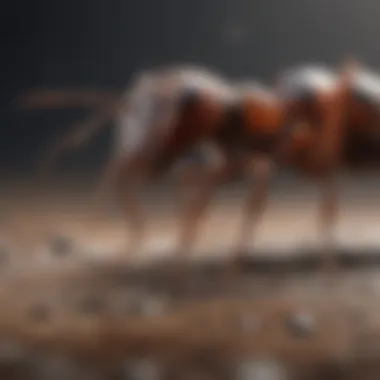Unveiling the Factors that Attract Ants and Effective Elimination Strategies


Animal Species Profile
Ants, small but highly organized insects, play a significant role in ecosystems worldwide. These fascinating creatures come in various species, each displaying distinct physical characteristics and behaviors. Ants are known for their hard exoskeletons, segmented bodies, six legs, and antennae. Their colors range from black and brown to reddish hues, blending into their natural surroundings. While not possessing remarkable size, their strength lies in unity and teamwork.
Ants are versatile insects found in diverse habitats worldwide, from forests and grasslands to urban areas. They thrive in soil, decaying wood, under rocks, and even inside buildings. Colonies vary in size, with queens, workers, and soldiers fulfilling specific roles to ensure survival and expansion. Their ability to adapt to different environments contributes to their widespread distribution across the globe.
Intriguingly, ants exhibit complex social behaviors within their colonies. They communicate through pheromones, tactile cues, and even vibrations to convey messages related to foraging, defense, and reproduction. Some ant species engage in farming aphids for honeydew, showcasing fascinating symbiotic relationships. Their intricate social interactions demonstrate a high level of organization and cooperation essential for colony success and longevity.
Animal Behavior & Psychology
Ants' behavior and psychology provide remarkable insights into their intricate world. Through sophisticated communication systems, ants convey messages vital for colony functioning. They use chemical signals called pheromones to mark trails, warn of danger, and regulate division of labor. This precise communication enables seamless coordination in various tasks, such as food collection, nursing larvae, and defending the nest.
Reproductive behavior in ants follows specific patterns, with queens solely responsible for laying eggs to ensure colony expansion. Male ants have the role of mating with the queen, after which they often perish. Worker ants, predominantly females, undertake diverse responsibilities crucial for colony maintenance. Their dedication to tasks like nest construction, foraging, and caring for the young sustains the colony's productivity and well-being.
Moreover, ants exhibit impressive cognitive abilities essential for problem-solving and navigation. By using memory, spatial orientation, and pattern recognition, they navigate complex terrain to locate food sources and transport resources back to the nest efficiently. This cognitive prowess enhances their survival in challenging environments and enables adaptive responses to changing conditions.
Emotional intelligence and social dynamics also play a vital role in ant colonies. They display altruistic behaviors, sacrificing individual interests for the greater good of the colony. Ants show empathy towards injured comrades, assisting in their recovery and integration back into the group. This emotional connection fosters cohesion and resilience within the colony, highlighting the significance of social bonds in ant societies.
Unique Facts & Trivia
Delving into the intriguing world of ants reveals a treasure trove of unique facts and quirky behaviors. Did you know that some ant species practice agriculture by cultivating fungus for food production? This agricultural behavior showcases their resourcefulness and adaptability. Additionally, certain ant species engage in slavery, raiding neighboring colonies to capture worker ants and integrate them into their workforce.
Fun trivia surrounds ants' impressive physical capabilities, such as their ability to carry objects several times their weight. This feat, attributed to their muscle structure and biomechanics, demonstrates their exceptional strength relative to size. Another fascinating fact is ants' complex navigation system, which utilizes landmarks, patterns of sunlight, and polarized light cues for orientation and communication.
Record-breaking feats further highlight ants' remarkable abilities. The Saharan silver ant holds the record for being the fastest ant species, clocking astounding speeds in search of food under the scorching desert sun. Ants' resilience to extreme conditions, efficient foraging strategies, and collective intelligence showcase their evolutionary success and adaptation as a formidable insect species.
Pet Care & Tips
While ants are typically viewed as pests in households, some enthusiasts choose to keep them as pets in formicariums (ant farms). If considering ant-keeping as a hobby, preparation is crucial to ensure the well-being of the colony. Selecting the right ant species compatible with captivation is essential, considering factors like diet, nesting preferences, and climate suitability.
Basic care requirements for pet ants include providing a suitable habitat with adequate space, nesting materials, and moisture levels. Monitoring food and water availability, temperature regulation, and colony health are vital aspects of responsible ant ownership. Additionally, enriching the environment with challenges like foraging puzzles and tunnels promotes behavioral stimulation and naturalistic behaviors.
Maintaining the health and wellness of pet ants involves regular observation and hygiene practices. Cleaning the formicarium, managing pest infestations, and preventing overcrowding ensure a conducive environment for colony longevity. Adhering to proper feeding schedules, dietary diversity, and balanced nutrition supports the overall well-being and vitality of captive ant populations.
Training techniques, though not conventional for ants, can involve conditioning behaviors through positive reinforcement. Associating specific cues with rewards can encourage desired actions within the colony, facilitating interaction and responsiveness. Behavioral enrichment ideas like introducing new stimuli, varying food sources, or simulating natural foraging scenarios enhance the mental and physical engagement of pet ants, promoting a fulfilling and enriching experience.
Introduction
In this section, we delve into the intricate world of understanding what attracts ants and how to effectively eliminate them from our living spaces. Ant infestations can be a nuisance, and comprehending the factors that draw them in is key to keeping them at bay. By exploring the behaviors and preferences of ants, individuals can create strategic plans to combat these pesky insects. From identifying attractants to implementing practical elimination methods, this guide equips readers with valuable insights for maintaining an ant-free environment.
Brief Overview of the Ant Attraction Phenomenon


Factors Influencing Ant Behavior
Exploring the nuances of factors influencing ant behavior sheds light on why these tiny creatures gravitate towards specific environments. Understanding the intricate cues that steer ant activities is crucial in formulating effective eradication strategies. By dissecting these factors, we gain valuable insights into the root causes of ant attractions and how to disrupt them strategically. Despite the challenges, decoding these behaviors stands as a pivotal step in combating ant infestations.
Importance of Understanding Ant Attraction
Unraveling the importance of grasping ant attraction sheds light on why it is a fundamental aspect of pest control. By delving into the intricacies of what draws ants in, individuals can proactively address potential hotspots for infestations. Identifying these attractions not just resolves current issues but also aids in preventing future invasions, making it a cornerstone in the battle against ants. Acknowledging and comprehending these attractions elevates one's ability to tackle ant problems effectively.
Consequences of Ignoring Ant Infestations
The consequences of turning a blind eye to ant infestations can be detrimental to both health and property. Ignoring these tiny invaders can lead to widespread infestations, causing significant damage, especially in food storage areas. Neglecting to address ant issues promptly can result in a multitude of problems, ranging from health hazards to property damage. Understanding these repercussions underscores the urgency of taking proactive measures to eliminate ants effectively.
Significance of Identifying Ant Attractants
Delving into the significance of identifying ant attractants unveils crucial insights into combating ant infiltrations. Recognizing common household attractants allows individuals to pinpoint areas susceptible to infestations, enabling targeted interventions. Furthermore, understanding outdoor factors contributing to ant presence provides a holistic view of the various entry points ants exploit. Highlighting the impact of food remnants underscores the importance of proper waste management in deterring these pests effectively.
Factors That Attract Ants
Ants are highly attracted to specific stimuli in their environment, making it crucial to understand the factors that draw them in. By comprehending what lures ants, individuals can effectively combat infestations. Ants' behavior is influenced by various elements such as sensory cues, pheromones, food sources, and environmental conditions. Each of these factors plays a significant role in attracting ants to different spaces. Recognizing and addressing these attractants is key to ant control and prevention.
Sensory Cues and Pheromones
Ants rely heavily on sensory cues and pheromones for communication and navigation. Chemical signals play a vital role in attracting ants to food sources or signaling danger. These pheromones contribute to the ants' social organization and behavior. Understanding the specific chemical signals that attract ants is crucial for devising effective strategies to deter them. While some chemical signals draw ants for foraging purposes, others alert them to potential threats.
Chemical Signals That Attract Ants
One of the fundamental aspects of chemical signals that attract ants is their ability to communicate food availability within the colony. Ants release these signals to guide their nestmates to food sources, creating efficient foraging patterns. The key characteristic of these signals is their persistence, remaining detectable by ants for extended periods. While beneficial in food location, these signals can inadvertently lead ants to unwanted areas if not controlled effectively. Managing these chemical trails is essential in preventing widespread ant infestations.
Role of Pheromones in Ant Communication
Pheromones play a crucial role in ant communication, shaping their social interactions and division of labor. These chemical messengers convey information about food sources, colony status, and even mating readiness. The distinctive feature of pheromones lies in their specificity, with each type serving a unique communicative purpose. While advantageous in coordinating ant activities, over-reliance on pheromones can result in behavioral rigidity and vulnerability to disruption. Balancing the use of pheromones is essential in maintaining colony functionality and responding to environmental changes.
Food Sources and Availability
The type and availability of food directly influence ant attraction and infestation patterns. Certain foods act as strong attractants for ants, prompting them to invade living spaces in search of sustenance. Additionally, how food is stored impacts the likelihood of ant infestations. Proper food storage practices can significantly deter ants and minimize the risk of unwelcome intrusions.
Types of Foods Highly Attractive to Ants
Ants exhibit a preference for sugary, protein-rich, and oily foods, making these categories highly attractive to them. Sugary substances, in particular, are irresistible to ants, prompting them to scout for these sources diligently. Understanding which foods ants find most appealing enables individuals to implement targeted elimination strategies. By removing or securing these attractants, households can effectively reduce ant incursions.
Impact of Food Storage on Ant Infestations


The way food is stored can either attract or repel ants. Improperly sealed containers or exposed food remnants serve as beacons for foraging ants. Additionally, food spills or unclean surfaces create conducive environments for ant infestations. Proper food storage practices, such as sealing containers and promptly cleaning spills, are critical in preventing ant attraction and subsequent infestations.
Environmental Conditions
Environmental factors like temperature, humidity, and shelter availability play a significant role in ant behavior and attraction. Ants seek out specific conditions that provide favorable living spaces, influencing their nesting and foraging behaviors. Understanding these environmental preferences is essential in developing holistic ant control strategies.
Role of Temperature and Humidity
Temperature and humidity levels impact ant activity and reproduction rates. Ants thrive in moderate temperatures with ample humidity, facilitating colony growth and resource exploitation. Maintaining indoor conditions that are less favorable to ants, such as lower humidity levels or controlled temperatures, can deter infestations.
Shelter Preferences of Ants
Ants exhibit distinct preferences for shelter locations, seeking out hidden, dark spaces for nesting. Cracks in walls, gaps in flooring, or humid areas are commonly preferred hiding spots for ants. Identifying and sealing these potential entry points is crucial in limiting ant access to indoor spaces. By addressing shelter preferences, individuals can actively prevent ant infestations and reduce favorable nesting sites.
This detailed exploration shines a light on the intricate world of ant attraction and provides valuable insights into effective elimination strategies. By understanding the factors that entice ants and implementing targeted interventions, individuals can safeguard their living spaces from unwanted ant presence.
Effective Strategies for Ant Elimination
Effective Strategies for Ant Elimination plays a crucial role within this article as it delves into practical methods to eradicate ants effectively. By focusing on specific elements such as natural and non-toxic remedies, chemical treatments, and preventive measures, readers gain valuable insights into combatting ant infestations. These strategies not only offer environmentally friendly solutions but also aim to provide long-term results, ensuring a pest-free environment for individuals. By understanding the importance and implications of different eradication approaches, readers can make informed decisions tailored to their unique circumstances.
Natural and Non-Toxic Remedies
Utilization of Essential Oils
Discussing the Utilization of Essential Oils sheds light on a specific aspect of ant elimination, showcasing its significance in the overall goal of eradicating ants effectively. Essential oils are known for their natural properties that repel ants without harsh chemicals, making them a popular choice for eco-conscious individuals. The unique feature of Utilization of Essential Oils lies in its ability to offer a non-toxic yet potent solution against ant infestations. While their advantages include a pleasant aroma and minimal environmental impact, individuals must be aware of potential limitations such as varying efficacy levels based on ant species and infestation severity.
Vinegar Solutions for Ant Control
Exploring Vinegar Solutions for Ant Control unveils another non-toxic remedy integral to the ant elimination process. Vinegar is acclaimed for its acidic properties that disrupt ant trails and deter them from entering living spaces. This approach serves as an accessible and affordable method for controlling ant populations, particularly in household settings. The distinctive feature of Vinegar Solutions for Ant Control lies in its versatility and natural composition, making it an attractive choice for individuals seeking alternative pest management solutions. While its benefits include versatility and ease of use, potential drawbacks may include temporary odors and the need for consistent application depending on ant activity levels.
Chemical Treatments
Popular Insecticides for Ant Eradication
Diving into Popular Insecticides for Ant Eradication introduces a different facet of ant elimination, emphasizing the role of chemical treatments in combating severe infestations. These insecticides are formulated specifically to target ants effectively, offering a swift and potent solution for persistent ant problems. The key characteristic of Popular Insecticides for Ant Eradication is its rapid action and ability to eradicate large ant colonies efficiently. While their advantages include immediate results and broad applicability, individuals must exercise caution due to potential toxicity levels and environmental considerations.
Guidelines for Safe Chemical Application
Discussing Guidelines for Safe Chemical Application provides essential insights into the responsible use of chemical treatments for ant eradication. These guidelines focus on best practices for applying insecticides to minimize risks to human health and the environment. The unique feature of Guidelines for Safe Chemical Application lies in its emphasis on safety protocols and meticulous application techniques. While their advantages encompass effective pest control and targeted treatment, individuals must adhere strictly to usage instructions and recommended safety precautions to prevent adverse effects on non-target organisms and ecosystems.
Preventive Measures to Deter Ants


Sealing Entry Points
Exploring Sealing Entry Points illuminates a proactive approach to ant prevention by addressing potential entryways that ants use to infiltrate buildings. Sealing cracks, gaps, and openings in structures effectively blocks ant access, reducing the likelihood of infestations. The key characteristic of Sealing Entry Points lies in its focus on fortifying the home's defenses against ant intrusion through physical barriers. While its advantages include long-term protection and cost-effectiveness, individuals should be vigilant in identifying and sealing even minor entry points to maintain a secure environment.
Maintaining Cleanliness and Hygiene Practices
Delving into Maintaining Cleanliness and Hygiene Practices underscores the importance of sanitation in deterring ant activity and minimizing attractants. Regular cleaning routines, proper food storage, and waste management play a pivotal role in reducing ant infestations by eliminating food sources. The unique feature of Maintaining Cleanliness and Hygiene Practices lies in its preventive nature, promoting habits that discourage ant foraging and nesting behaviors. While their advantages encompass sustainable pest control and improved indoor hygiene, consistent adherence to cleanliness standards is essential to prevent recurrent ant incursions.
Professional Pest Control Services
Professional pest control services play a crucial role in ensuring the effective elimination of ants while safeguarding living spaces. These services offer specialized treatments tailored to target ant infestations, utilizing a combination of knowledge and equipment to address pest-related challenges comprehensively. By enlisting the assistance of pest extermination experts, individuals can benefit from their in-depth understanding of ant behavior and effective eradication techniques.
Additionally, professional pest control services provide a layer of protection against recurring ant infestations. The expertise of these specialists extends beyond mere eradication, focusing on preventive measures to deter future ant intrusions. By assessing the unique requirements of each situation, pest control services can offer tailored solutions that promote long-term ant control.
Undeniably, the efficiency and effectiveness of professional pest control services lie in their ability to employ advanced equipment and techniques. These experts are equipped with industry-leading tools specifically designed for pest management. From targeted insecticides to specialized baits, their arsenal is curated to tackle ant infestations efficiently, minimizing environmental impact while maximizing results.
Overall, the utilization of professional pest control services represents a strategic investment in maintaining a pest-free environment. By leveraging the knowledge and proficiency of these experts, individuals can rest assured that their homes are safeguarded against the persistent threat of ant infestations.
Benefits of Hiring Pest Extermination Experts
Specialized Knowledge and Equipment
Specialized knowledge and equipment form the cornerstone of effective pest extermination services. These professionals undergo rigorous training to understand the intricacies of ant behavior, allowing them to develop targeted strategies for eradication. Their expertise extends to the identification of ant species, key attractants, and optimal treatment methods.
Moreover, the equipment utilized by pest extermination experts is tailored to maximize efficiency and precision. Advanced technologies such as thermal imaging cameras and microencapsulated insecticides enable these specialists to detect and eliminate ant colonies with unparalleled accuracy. This sophisticated equipment enhances the effectiveness of treatments while minimizing environmental impact.
In essence, the combination of specialized knowledge and advanced equipment sets pest extermination experts apart, ensuring thorough and meticulous ant eradication. Their ability to strategize based on scientific understanding and technological innovation makes them a valuable asset in combating ant infestations.
Long-Term Solutions for Ant Infestations
Long-term solutions for ant infestations focus on addressing underlying factors that contribute to pest presence. Pest extermination experts emphasize not only the eradication of existing ants but also the implementation of preventive measures to deter future infestations. By targeting ant attractants, sealing entry points, and recommending proactive strategies, these professionals offer sustainable solutions for long-term ant control.
Moreover, the expertise of pest extermination experts enables them to customize treatment plans based on the specific needs of each property. By conducting thorough inspections and assessing environmental conditions, they can devise comprehensive strategies that address root causes of infestations. This proactive approach goes beyond temporary fixes, providing lasting relief from ant invasions.
Ultimately, long-term solutions for ant infestations underscore the commitment of pest extermination experts to preserve pest-free environments. Their focus on preventative measures and strategic planning not only eliminates current ant populations but also fortifies properties against future infestations, ensuring a sustained barrier against pest intrusion.
Conclusion
In the culmination of this comprehensive guide on understanding what attracts ants and effectively eliminating them, it becomes evident that proactive measures are paramount in maintaining an ant-free environment. The importance of this conclusion lies in the meticulous approach required to combat ant infestations consistently. By implementing a combination of preventive strategies and strategic elimination techniques, individuals can safeguard their living spaces from these persistent pests. This section serves as a reminder of the continuous effort and vigilance necessary to ward off ant intrusions effectively.
Key Takeaways for Ant Prevention and Elimination
Importance of Regular Maintenance Practices
In the realm of ant prevention and elimination, the concept of regular maintenance practices emerges as a cornerstone of defense against infestations. The significance of this aspect stems from its proactive nature, aiming to address ant attractants before they escalate into full-blown infestations. Regular maintenance involves conducting routine inspections, sealing entry points, and practicing cleanliness to mitigate attractants. This proactive approach not only deters ants but also prevents other pest incursions, promoting overall household hygiene. The unique feature of regular maintenance lies in its sustainability, offering long-term protection against ant invasions. While the dedication to regular upkeep may require consistent effort, the benefits of a pest-free environment and peace of mind outweigh the maintenance commitment.
Continuous Vigilance Against Ant Intrusions
Continuous vigilance against ant intrusions is a fundamental component of ant prevention strategies. By remaining vigilant, individuals can promptly identify signs of ant activity and address them before they escalate. The key characteristic of this practice is its swift response to any indication of ant presence, preventing infestations from taking hold. Maintaining consistent vigilance enables early intervention, limiting the spread of ants within the property. The unique feature of continuous vigilance lies in its proactive nature, aligning with the preventive theme of ant management. While the need for perpetual alertness may seem demanding, the proactive stance ensures minimal disruptions from ant intrusions and underscores the effectiveness of persistent monitoring for long-term ant control.







